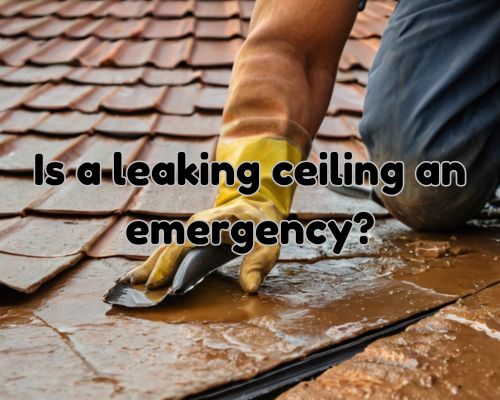
Is a Leaking Ceiling an Emergency? Essential Facts You Need to Know
A leaking ceiling can start as a small inconvenience, but it often escalates quickly into a serious issue.
Yes, a leaking ceiling is typically considered an emergency. It can significantly impact the structural integrity of your home and lead to costly repairs.
Based on CJ Commercial Roofing NJ, the causes of ceiling leaks are varied, but they often stem from roof damage, like missing shingles or worn-out flashing.

When water infiltrates these vulnerabilities, it can pool on your ceiling, leading to potential water damage.
Quick action is crucial in preventing further complications.
Ignoring a ceiling leak could lead to more than just unsightly stains. It can result in hidden mold growth or even structural weaknesses in your apartment or house.
Knowing the risks and how to respond can save you from extensive damage and unexpected repair expenses.
Identifying and Understanding Ceiling Leaks
Identifying a ceiling leak requires noticing visual cues and understanding potential causes.
Risks such as mold, structural damage, and safety hazards make responding promptly crucial.
Types of Ceiling Leaks
Ceiling leaks can originate from various sources, each requiring distinct attention.
Roof leaks often result from damaged shingles or cracked flashing.
Meanwhile, plumbing leaks might arise from faulty pipes or fixtures above the ceiling.
Additionally, condensation leaks can occur if there is insufficient insulation in the attic causing moisture build-up.
Differentiating these types aids in determining the appropriate response and repair.
Common Causes and Indicators
Several factors can lead to ceiling leaks.
Roof leaks are common, especially after severe weather, due to missing shingles or damaged flashing.
Meanwhile, plumbing issues such as broken pipes or leaking joints can also lead to water infiltration.
Indicators of leaks include water stains, typically rust-colored rings, bubbling or flaking paint, and sagging ceiling tiles. A musty odor may suggest mold growth, emphasizing the need for a thorough inspection.
Assessing the Severity of the Leak
The severity of a ceiling leak determines the urgency of the response needed.
A slow leak might go unnoticed until structural damage or mold becomes visible, posing a significant health risk.
Conversely, a rapidly spreading water stain or sagging ceiling suggests an immediate threat to structural integrity.
Meanwhile, hairline cracks may indicate minor issues, while larger cracks or bowing ceilings generally suggest severe underlying problems.
Immediate Steps to Minimize Damage
To limit damage from a ceiling leak, quick action is essential.
Start by moving furniture and valuables away from the affected area to prevent water damage.
Then, place buckets or a tarp under the leak to catch dripping water.
Identify and stop the water source, whether a plumbing issue or a roof leak.
If safe, remove excess water and debris from the ceiling to reduce weight and pressure, minimizing potential ceiling collapse.
Professional Intervention and Repair
When dealing with a leaking ceiling, timely action is critical to prevent worsening damage and potential safety hazards.
Professional assistance ensures the problem is assessed accurately, repairs are effectively carried out, and future issues are minimized.
When to Contact a Professional
You should contact a professional if the ceiling leak is causing visible sagging, severe water stains, or signs of ceiling collapse. These are strong indicators of significant water damage that could compromise structural integrity.
Additionally, if you notice musty smells or suspect plumbing leaks, it’s time to seek expert help.
Water damage can lead to hidden electrical hazards or contamination from condensation, requiring a trained eye and comprehensive repairs.
Documenting and Reporting Water Damage
It’s important to thoroughly document the damage before and during repair processes.
Use photographs and detailed notes to accurately record the extent of ceiling water damage.
This documentation not only assists in conveying the situation to professionals but also serves as vital evidence when dealing with insurance claims.
For instances requiring water damage restoration, proper documentation aids in ensuring the restoration team understands the full scope of necessary repairs.
Remember that any delay in reporting may complicate claims.
Selecting the Right Experts
Choosing the right experts is crucial for successful and efficient ceiling repair.
Look for a roofing contractor like CJ Commercial Roofing NJ, with experience in handling leaks and damaged flashing, which are often culprits in ceiling issues.
Verify their credentials and ask for a roof inspection before contracting their services.
For complex water damage repair, seek a team that offers comprehensive services.
These should include the drying process and prevention of future leaks.
Collaboration between your maintenance team and external experts can lead to a seamless resolution.
Check reviews and references to ensure their expertise aligns with your needs.





